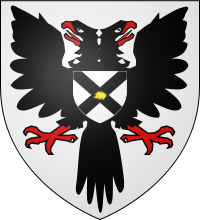
Earl of Nithsdale
Encyclopedia

Peerage of Scotland
The Peerage of Scotland is the division of the British Peerage for those peers created in the Kingdom of Scotland before 1707. With that year's Act of Union, the Kingdom of Scotland and the Kingdom of England were combined into the Kingdom of Great Britain, and a new Peerage of Great Britain was...
. It was created in 1620 for Robert Maxwell, 9th Lord Maxwell, with remainder to heirs male. He was made Lord Maxwell, Eskdale and Carlyle at the same time. The title of Lord Maxwell had been created in the Peerage of Scotland in 1445 for Herbert Maxwell.
Some confusion in the numbering of the Lords Maxwell has arisen from the second Lord's surrender of his barony during his lifetime in favour of his son, who then pre-deceased him. Some authorities refer to the son only as "the Master of Maxwell", but he is more usually counted as the third Lord Maxwell.
The fourth Lord was killed at the Battle of Flodden in 1513. On the second Earl of Nithdale's death in 1667 the titles were inherited by John Maxwell, 7th Lord Herries of Terregles, who became the third Earl. He was the great-grandson of Sir John Maxwell, second son of Robert Maxwell, 5th Lord Maxwell. His grandson, the fifth Earl, was involved in the Jacobite Rising of 1715
Jacobite rising
The Jacobite Risings were a series of uprisings, rebellions, and wars in Great Britain and Ireland occurring between 1688 and 1746. The uprisings were aimed at returning James VII of Scotland and II of England, and later his descendants of the House of Stuart, to the throne after he was deposed by...
and attainted with his titles forfeited. However, Lord Nithsdale made a celebrated escape from the Tower of London
Tower of London
Her Majesty's Royal Palace and Fortress, more commonly known as the Tower of London, is a historic castle on the north bank of the River Thames in central London, England. It lies within the London Borough of Tower Hamlets, separated from the eastern edge of the City of London by the open space...
by changing clothes with his wife the day before his execution. The titles are considered to have become extinct on the death of his son, except the Lordship of Herries of Terregles
Lord Herries of Terregles
Lord Herries of Terregles is a title in the Peerage of Scotland. It was created in 1490 for Herbert Herries. On the death of his grandson, the third Lord, the male line failed. He was succeeded by his daughter Agnes. She married Sir John Maxwell, second son of Robert Maxwell, 5th Lord Maxwell...
, which remains extant.
Lords Maxwell (1445)
- Herbert Maxwell, 1st Lord Maxwell (d. c.1454)
- Robert Maxwell, 2nd Lord Maxwell (d. c.1485)
- John Maxwell, 3rd Lord Maxwell (c.1476–1513)
- Robert Maxwell, 4th Lord Maxwell (d. 1552)
- Robert Maxwell, 5th Lord MaxwellRobert Maxwell, 5th Lord MaxwellRobert Maxwell, 5th Lord Maxwell , A member of the council of Regency of the Kingdom of Scotland. Regent of the Isle of Arran and like his father before head of the clan Maxwell. A distinguished Scottish nobleman, politician, soldier and in 1513 Lord High Admiral...
(d.c.1553) - Robert Maxwell, 6th Lord Maxwell (1551–1555), aged four years
- John Maxwell, 7th Lord Maxwell (1553–1593), briefly the Earl of MortonEarl of MortonThe title Earl of Morton was created in the Peerage of Scotland in 1458 for James Douglas of Dalkeith. Along with it, the title Lord Aberdour was granted. This latter title is the courtesy title for the eldest son and heir to the Earl of Morton....
, between 1581–1586 - John Maxwell, 8th Lord Maxwell (1583–1613)
- Robert Maxwell, 9th Lord Maxwell (1586–1646) (created Earl of Nithsdale in 1620)
Earls of Nithsdale (1620)
- Robert Maxwell, 1st Earl of Nithsdale (1586–1646)
- Robert Maxwell, 2nd Earl of Nithsdale (1620–1667)
- John Maxwell, 3rd Earl of Nithsdale (d.1677)
- Robert Maxwell, 4th Earl of Nithsdale (1628–1696)
- William Maxwell, 5th Earl of NithsdaleWilliam Maxwell, 5th Earl of NithsdaleWilliam Maxwell, 5th Earl of Nithsdale was a Catholic nobleman, who took part in the Jacobite Rising of 1715.He was the eldest son of Robert, fourth Earl of Nithsdale , and Lady Lucie Douglas , daughter of William, eleventh earl of Angus and first Marquess of Douglas. He was probably born at...
(1676–1744) (attainted 1716 and peerages forfeit)

